The spark plug is an essential component in gasoline internal combustion engines. Its main purpose is to ignite the air-fuel mixture in the combustion chamber using a precise and powerful electrical spark. Its performance directly influences engine efficiency, power, and emissions. Main components of a spark plug: Connection terminal: The connection point with the ignition cable. Receives high-voltage current from the coil. Internal resistor: Reduces electromagnetic interference. Protects the vehicle's electronic systems. Ceramic insulator: Made of aluminum oxide. Electrically insulates the conductive core and withstands high temperatures (up to 1200°C). Metal body (thread and hexagon): Allows the spark plug to be installed in the cylinder head. Facilitates tightening with a torque wrench. Center electrode: Made of materials such as nickel, platinum, or iridium. Conducts the current to the tip where the spark is generated. Ground electrode: Welded to the metal body. Completes the electrical circuit by receiving the spark from the center electrode. Operating Principle The ignition system generates a high-voltage current (between 12,000 and 45,000 V) that reaches the spark plug. The current passes through the center electrode, sparking the ground electrode (crossing the gap of 0.6 to 1.1 mm). This spark ignites the air-fuel mixture inside the cylinder, generating the explosion that propels the piston. The effectiveness of a spark plug depends on the heat of the insulation, the shape and material of the electrodes, and the precision of the space between them (gap). A worn spark plug can cause misfires, loss of power, and increased fuel consumption. Iridium and platinum spark plugs dominate the premium segment due to their longer lifespan and efficiency. Brands such as NGK and Denso lead the way in Asian vehicles, while Bosch and Champion are preferred in Europe and America.
CONTACT
Email: info@recambiosdeautomovil.com














































